Fig. 8.1
Infant whole body plethysmography for assessment of functional residual capacity. Photo courtesy of Janet Stocks. (NB: Parental permission has been obtained to reproduce all photographs in this chapter. Copyright for all illustrations has been retained by Janet Stocks)
Functional residual capacity (FRC) and indices of ventilation inhomogeneity (such as the Lung Clearance Index or LCI) using multiple breath inert gas washout (MBW) techniques [15, 25–27] (see Chap. 10) and
Forced expiratory flow-volume (FEFV) maneuvers, using the tidal or raised volume rapid thoraco-abdominal compression technique (Figs. 8.2 and 8.3) [8, 23, 24, 28–37]
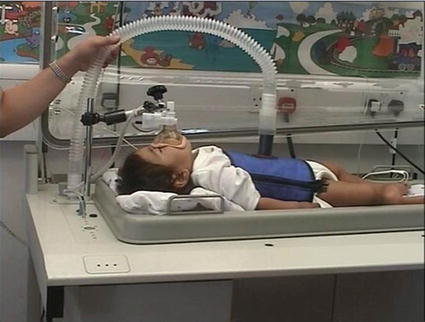
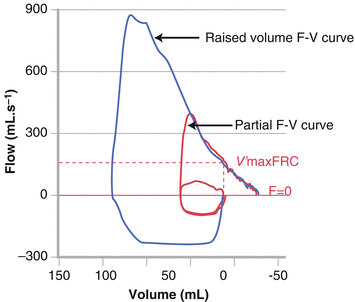

Fig. 8.2
The rapid thoraco-abdominal compression technique. Photo courtesy of Janet Stocks

Fig. 8.3
Forced expiratory flow–volume curves obtained during tidal breathing (partial F–V curve) and after inflating the lungs to 30 cmH2O (2.94 kPa) (raised volume F–V curve). Courtesy of Janet Stocks
Details of how to undertake these tests have been published elsewhere [14, 34, 38–45] and will only be summarized briefly here. Regrettably, although some groups have published results using this technique, valid measurements of plethysmographic airways resistance are not feasible using currently available commercial equipment [46, 47].
The choice of which test(s) to use in which infant, and the order in which they are performed, needs to be informed by the underlying reason for performing the test, the underlying assumptions of each test, the likely total duration of sleep (and hence testing session) and the level of expertise required for accurate measurements, rather than simple availability of equipment. Although recording of tidal breathing and respiratory mechanics using the occlusion technique appear simple, their validity can easily be compromised by leaks around the face mask, lack of quiet regular breathing or, in the case of single occlusion technique, violation of the theoretical assumptions underlying the measurements due to lack of complete relaxation during the occlusion and throughout the subsequent expiration and/or inability to represent the respiratory system by a single time constant in the presence of lung disease [14, 19, 43]. Strict quality control indicates that these conditions are frequently not met leading to a failure rate of at least 30 % [23]. Generally speaking, assessments based on quiet tidal breathing (e.g., respiratory mechanics using the occlusion technique, multiple breath washout or plethysmography) should be undertaken before those entailing forced expiratory maneuvers.
Which Tests Can Be Performed in Preschool Children?
Up until the last decade, it was commonly stated that assessment of lung function in preschool children (2–5 years) was virtually impossible, since they lacked the necessary coordination, comprehension and cooperation to participate, this period being dubbed the “dark ages” of pediatric pulmonology. Although this view is still held by many, there is now a considerable body of evidence that a wide range of lung function measurements are indeed feasible in the majority of children above 3 years of age, provided the techniques and quality control criteria are suitably adapted, and the tests are performed in a child-friendly environment by operators with suitable expertise and aptitude [9, 10, 13, 14, 32, 46, 48–68]. Success rate increases with age [13, 67, 68], with high success rates feasible from around 3.5 years, unless the child has been born very prematurely or has any signs of developmental delay.
As for all PFTs, appropriate equipment and testing conditions, skilled and experienced personnel, and rigorous adherence to published guidelines are critical for ensuring high quality, reproducible data. When assessing preschool children, it is essential to try and minimize equipment dead-space, especially if adapting that used for measurements in older subjects. For certain tests, especially those requiring long periods of tidal breathing, the use of a suitably selected video to distract and entertain the child (without inducing laughter or conversation!) can be very useful. For such tests, a face mask may be preferable to that of a mouthpiece in order to reduce risk of leaks and improve cooperation. However, the potential effect of any added dead-space when using a mask must be considered. Most young children tolerate a nose clip and mouth piece satisfactorily for short measurements such as spirometry.
PFTs that are now commonly applied in this age group include
Assessments using the MBW and forced oscillations are considered in Chap. 10 and will therefore not be addressed further here except in general terms.
Preschool Spirometry (Fig. 8.4): The use of carefully designed computerized incentives can be extremely helpful in gaining the young child’s cooperation in effort-dependent tests such as spirometry, but must be selected carefully and used interactively. For example, while blowing candles out is a useful means of teaching the child to blow out fast, it will rarely encourage the child to continue to blow out until residual volume is reached, for which alternative incentives such as a bowling alley may be more useful. Similarly, the operator must select the desired threshold that the child needs to reach, for which availability of appropriate reference equations is essential, as well as an appreciation of the child’s clinical condition. It is generally helpful to set targets somewhat higher than that anticipated, to increase these further to encourage maximal effort if the child readily achieves the initial target, but to always allow the child to “win” by the end of the session in order to provide encouragement and a desire to return for future assessments!
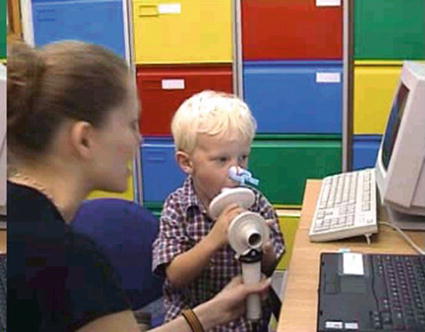

Fig. 8.4
Preschool spirometry. Photo courtesy of Janet Stocks
Young children have a much shorter expiratory time constant (relatively large airway caliber in relation to lung volume) than older subjects and therefore empty their lungs rapidly during forced expiration. In healthy children <5 years of age, expiration may be completed in less than a second, such that FEV1 cannot always be reported, FEV0.75 providing a useful alternative [67, 68, 80]. If undertaking spirometry in preschool children, it is essential that Quality Control (QC) criteria are adapted accordingly; stipulation that a forced expired time of at least 6 s or even 3 s must be achieved is likely to be associated with a high failure rate. Conversely, applying adult criteria with respect to repeatability criteria will likely lead to acceptance of unduly variable results [67, 68, 80].
Current data suggest that while spirometry can be successfully performed in the majority of preschool children with CF, it is far less sensitive than the lung clearance index (LCI) from multiple breath washout, such that while early lung disease can sometimes be detected, the abnormalities are on average mild and highly variable [10, 58]. Given its sensitivity in older children with Bronchopulmonary Dysplasia (BPD) [3], spirometry could potentially provide a useful longitudinal measurement for young children with BPD, in whom both lung growth and airway obstruction may be significantly abnormal in early life [2, 26, 81]. Unfortunately there is a paucity of data on preschool spirometry in children with BPD, possibly associated with the difficulty of undertaking this technique in young children if there is reduced concentration span or coordination, such as may occur following extremely preterm delivery. Spirometry is being increasingly used in children with recurrent wheezing, both to establish baseline lung function and document bronchodilator responsiveness (BDR) [14, 52, 62, 64, 82–84]. There are still limited data regarding the prevalence of BDR in normal preschool children and what constitutes a significant increase in forced expiratory volume after bronchodilator inhalation, but it has been suggested that a post-bronchodilator increase between 12 and 15 % in FEV0.75 or FEV1 is more commonly observed in preschool children with a clinical diagnosis of asthma than in healthy controls and exceeds the natural within-subject, between-test, within-occasion variability [52, 64, 67] . The use of FEF25–75 as an outcome to assess BDR is not recommended due to the high within and between-subject variability of this outcome [13]. Protocols for bronchial provocation and exercise testing in preschool children have been reported, but there is currently insufficient data to enable their use in clinical practice [13].
Plethysmographic Measurements of Specific Airway Resistance (sRaw)
sRaw is assessed while the child breathes tidally through a mouthpiece or modified facemask in a body plethysmograph (Figs. 8.5 and 8.6), without need for any special breathing maneuvers against an airway occlusion and is therefore well suited for preschool children. Since sRaw is the product of airway resistance (Raw) and FRC, both of which may increase in the presence of airway obstruction and hyperinflation, it is a potentially useful method for identifying obstructive lung disease in young children [14, 55, 72, 85]. sRaw has been found to be significantly elevated in preschool children with CF when compared with healthy controls, and appears to be more discriminative than spirometry to early lung disease, though less so than the lung clearance index [9, 10, 86]. sRaw has been used in longitudinal birth cohort studies and been found to be higher in asthmatic children than in healthy controls. Although it has been suggested that bronchial hyper-responsiveness and BDR can be successfully determined using sRaw, with fair discrimination between healthy young children and those with asthma or wheeze [55, 72], the extent to which even healthy young children demonstrate significant bronchodilator responsiveness, means that a reduction in sRaw by at least 25 % is required before the change can be considered clinically significant. A recent study concluded that the capacity of sRaw to discriminate between healthy young children and children with stable wheeze according to BDR is doubtful because of the large overlap in response between the two groups [52]. sRaw does not appear to have been used in children with prior BPD during the preschool years, possibly reflecting reduced concentration levels and delayed maturity in many of these children.
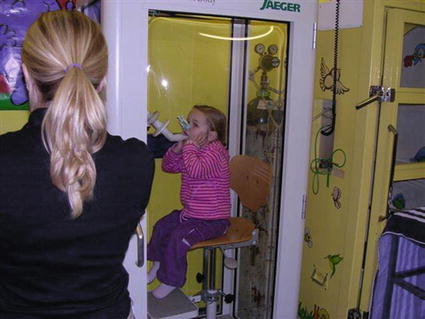
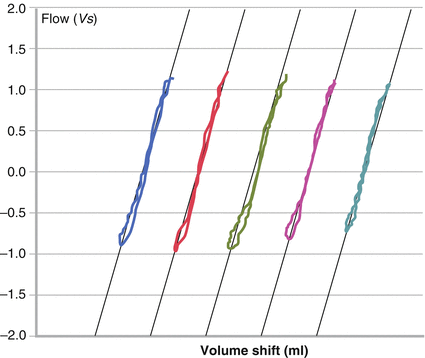

Fig. 8.5
Plethysmographic assessments of specific airways resistance in a preschool child. Photo courtesy of Janet Stocks

Fig. 8.6
Recording of plethysmographic pressure/flow loops for assessment of specific airway resistance. Courtesy of Janet Stocks
The Interrupter Technique
The interrupter resistance (Rint) technique is a quick, noninvasive measure of respiratory resistance that can be performed relatively easily in preschool children during tidal breathing. Rint is calculated from the ratio of pressure change to flow assessed at the airway opening during a brief (<100 ms) occlusion. Recent ATS/ERS guidelines recommend that occlusions for Rint occur during expiration. Although several studies have attempted to use Rint to assess lung function in preschool children with CF, the lack of discrimination between healthy children and those with CF suggests that Rint will have limited clinical utility in this population. Higher values of Rint have been observed in preschool children with severe BPD when compared without BPD, but there is considerable overlap between groups [87]. As summarized in the recent ATS document on clinical utility of PFTs in young children [13], baseline Rint does not discriminate well between healthy children and those with recurrent wheeze due to the large inter-subject variability in Rint values in health. The main application of this test may be to assess BDR in wheezy children, although a reduction in Rint of at least 30 % is required before changes are considered to be of clinical significance [56, 73].
Challenges to Using Infant PFTs in Clinical Management
Despite numerous attempts to monitor changes in lung function as a means of identifying early onset of pulmonary disease during the first year of life, the natural course of pulmonary involvement in infants with respiratory disorders remains relatively poorly understood, for the following reasons
Need for sedation
Confounding by developmental changes in respiratory physiology [14]
Lack of appropriate reference data
Lack of information regarding within- and between-subject variability, especially in those with lung disease, without which it is impossible to interpret serial measurements or response to interventions including bronchodilators
Difficulties in repeating measurements frequently enough to monitor change or long-term response to interventions accurately
Despite these significant challenges, among the 160 centers identified by a recent American Thoracic Society/European Respiratory Society (ATS/ERS) survey 37 (23 %) reported using infant PFTs purely for “clinical” applications and almost half of all respondents were using them to assess bronchodilator response (BDR). Given the time consuming nature of these tests (which may entail parents taking time off work), need for sedation and the considerable costs relating to equipment, consumables, and staffing costs for two specially trained and clinically qualified operators for each test [88], serious questions need to be asked regarding the clinical usefulness of results in any given child before undertaking or requesting infant PFTs “for clinical purposes.”
Challenges to Using PFTs in Clinical Management of Preschool Children
The challenges to using PFTs in the clinical management of preschool children are similar, albeit not so difficult to address, as those encountered when dealing with infants. Anyone who has tested very young children will appreciate that, in addition to needing to adapt the technique, equipment and quality control criteria as discussed above, much more time needs to be allocated to obtaining technically satisfactory results in this age group, especially during their first few visits to the laboratory. Problems relating to lack of appropriate reference data and hence confidence in what constitutes an “unusual” or “abnormal” result for a preschool child are beginning to be resolved, thanks to international efforts to collate data from healthy young children [85, 89–92]. However, with the exception of recent multi-ethnic spirometry equations [91] such reference equations remain largely limited to children of non-Hispanic White European descent. Although there remains limited information regarding within-subject, within and between-occasion variability with which to assess the clinical significance of any observed acute response to a bronchodilator or longer term response to other interventions [66, 67, 74], several recent papers have begun to address these issues [13, 52, 64, 67].
As when assessing infants, the choice of techniques must reflect the underlying research or clinical question. While techniques such as forced oscillation and interrupter technique are often considered simpler to apply in this age range, they still require considerable quality control during data collection and analysis and the wide between-subject variability in health may limit the extent to which they can identify abnormal lung function in those with lung disease. While spirometry is perfectly feasible in preschool children it has been shown to be far less sensitive than the LCI in identifying early lung disease in young children with CF [9, 10] (Box 8.1).
Box 8.1. Which PFTs Should Be Used When Assessing Infants and Preschool Children?
What is the research/clinical question?
What is the research/clinical question?
What is the underlying pathophysiology?
What is feasible in time available (duration of sleep in infants/concentration for young child)?
How much between-test variability may occur within any individual child?
Are valid reference equations available with which to interpret results?
Interpretation of Lung Function Results in Infants and Young Children and Their Role in Clinical Management
As in older subjects, the clinical usefulness of any lung function test within an individual infant or preschool child will always be enhanced if serial measures rather than a single assessment can be undertaken. However, during infancy the frequency with which PFTs can be repeated will be limited by need for sedation and the time consuming nature of the tests. When requesting such PFTs, it is essential that the choice of tests is based on the question to be answered, clinical reasoning, and a knowledge of the suspected underlying pathophysiology, rather than simply on the equipment that happens to be available in any given center [93]. Given the marked influence of factors such as preterm delivery, intrauterine growth retardation, sex, ethnic group, and maternal smoking during pregnancy, it is important to take a careful history from the parents when performing such tests in infants and young children with respiratory problems. It is also essential that such tests are only performed during periods of clinical stability, usually defined as being at least 2–3 weeks after any pulmonary exacerbation or upper respiratory tract infection. In addition to being potentially unethical due to the increased risk of sedation in a child who is acutely unwell or wheezing, attempts to assess efficacy of treatment by studying a child during the early phases of an exacerbation and then shortly after a course of antibiotics, corticosteroids, or bronchodilators, will at best reflect some natural improvement in lung function with time, but will provide minimal clinically useful information, unless part of a well-designed randomized trial with suitable placebo.
What Is Normal?
As discussed in more detail in Chap. 11, in order to identify the nature and severity of any underlying pathophysiology in an individual, it is essential to have a clear idea of the range of values to expect in a healthy child of similar age, sex, body size, and ethnicity. Reliable interpretation of pulmonary function results therefore relies on the availability of appropriate reference data to help distinguish between health and disease. The use of inappropriate reference equations and misinterpretation even when potentially appropriate equations are used, can lead to serious errors in both under and over-diagnosis, with its associated burden in terms of financial and human costs [94, 95]. It is important to remember that lung function results from healthy children and those with respiratory symptoms or disease often overlap to such an extent that a result within the normal range does not exclude disease. Similarly, while abnormal lung function results are often associated with symptoms and disease, they may simply be “atypical” and must always be interpreted in the light of all other clinically relevant information.
% Predicted or Z-Scores?
As discussed in Chap. 11, although clinicians in respiratory medicine are more familiar with the concept of expressing lung function as percent predicted, ([observed/predicted] × 100), a much better approach to interpreting lung function is to express results as Z-scores (or Standard Deviation Scores (SDS)) [94]. The Z-score is a mathematical combination of the percent predicted and the between-subject variability to give a single number that accounts for sex, age and height-related lung function variability expected within comparable healthy individuals (and, in certain cases also adjusts for ethnicity) [91]. The upper and lower limits of the normal range (ULN and LLN) are conventionally defined as Z-score of ±1.64, a range that encompasses 90 % of healthy subjects. However, due to increased uncertainty regarding reliability of reference ranges for infants and young children and the fact that multiple PFTs are often used in the assessment, these limits should be set at ±1.96 Z-scores to encompass 95 % of the healthy population. An increasing number of clinical research studies are now reporting infant and preschool lung function as Z-scores [8, 10, 21, 23, 24, 33, 52, 64, 82, 96, 97]. Particular caution is required when interpreting results which lie close to the somewhat arbitrary “cutoffs” between the normal range seen in health and suspected disease, especially when results are limited to a single test occasion. As with all tests, PFTs should be seen as only one part of the whole clinical picture.
Reference Equations for Infant PFTs
Marked biases between predicted values can occur due to alterations in equipment and protocol, differences in population characteristics, the statistical methods applied or simply as a result of sampling error due to too few healthy subjects being studied. There is currently a dearth of appropriate reference equations for infant PFTs, many users relying on outdated values, based on too few subjects and collected with different equipment and software than is now available commercially. This can result in serious misdiagnosis and adversely affect interpretation of clinical research studies. The need for sedation and the time consuming nature of the testing procedure limits the number of healthy infants who can be studied at any one center. International collaborative efforts are urgently needed to address this problem before clinical studies in individual infants can be interpreted properly. As discussed in a recent editorial [98], issues surrounding the ethics of recruiting healthy infants for PFTs need to be addressed as an urgent priority, if we are to interpret results from those with lung disease with any confidence.
It has been shown that, whether using the tidal or Raised volume technique, serious mis-interpretation of forced expiratory maneuvers that are obtained with modern, commercially available equipment will occur if based on published reference equations derived from customized equipment developed within a different laboratory [99]. While a temporary adjustment factor has been proposed to address this problem, there is an urgent need to collate data from healthy infants studied in different laboratories but using the same protocols, equipment, and quality control, so that reliable, up to date reference equations can be developed. Given the impact of ethnicity on spirometric lung function in older subjects [91], such an initiative should not be restricted to infants of white European descent. Reference equations for tidal breathing, passive respiratory mechanics and plethysmographic FRC derived from healthy white infants studied using modern equipment have been published recently [100] but still require validation using data collected in other departments.
Stay updated, free articles. Join our Telegram channel

Full access? Get Clinical Tree


